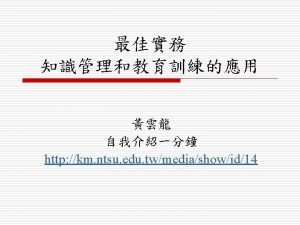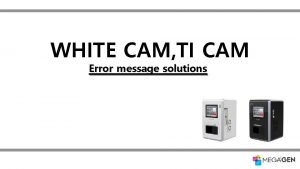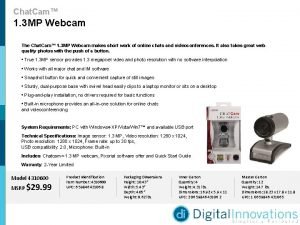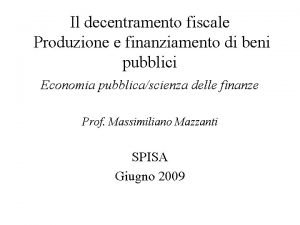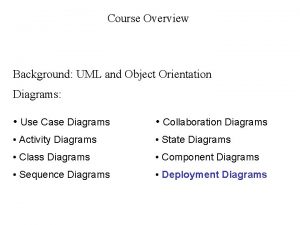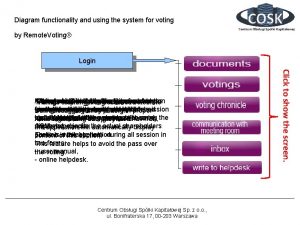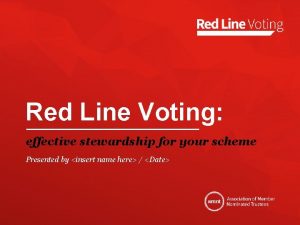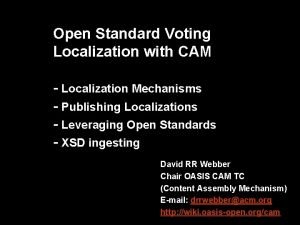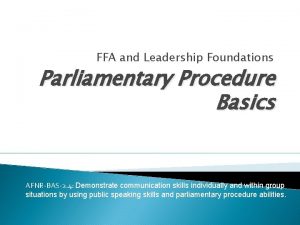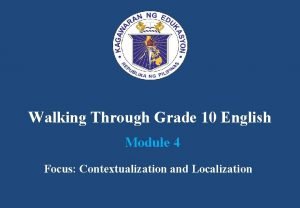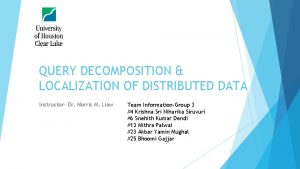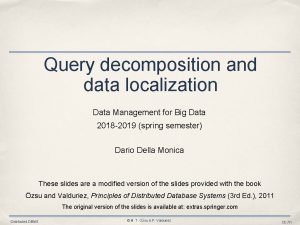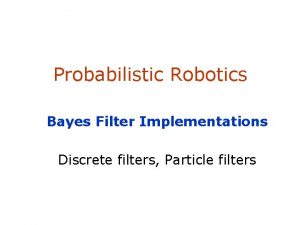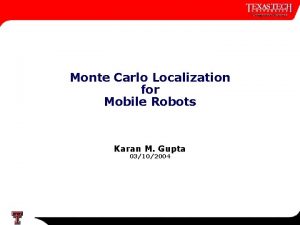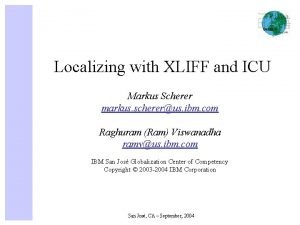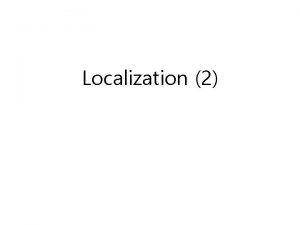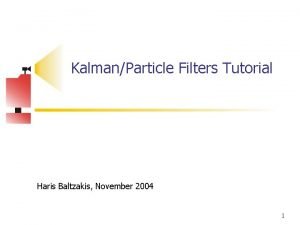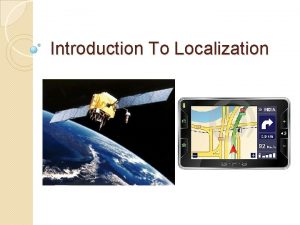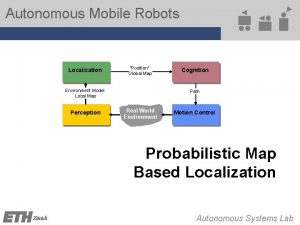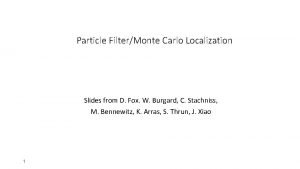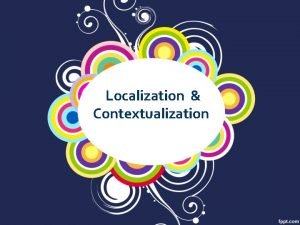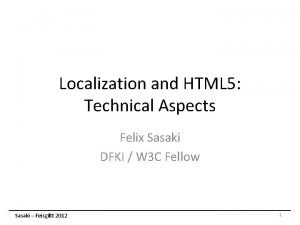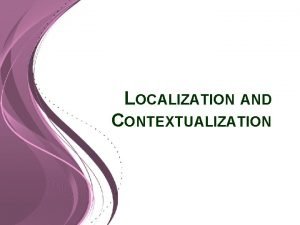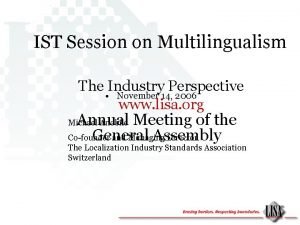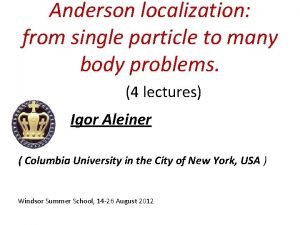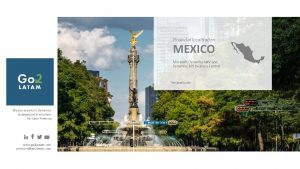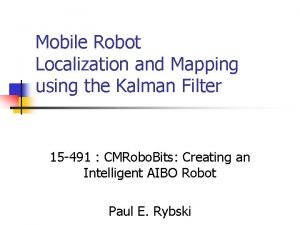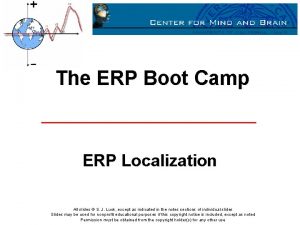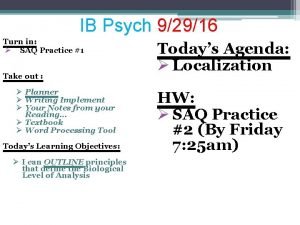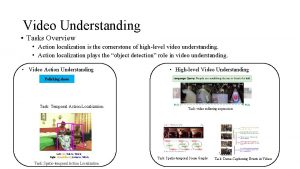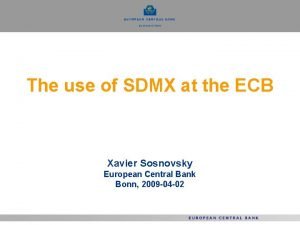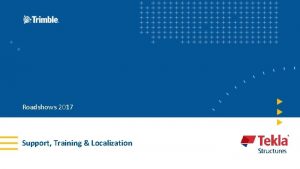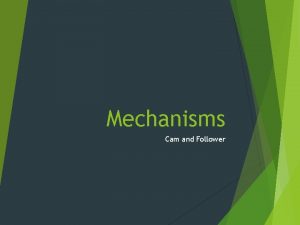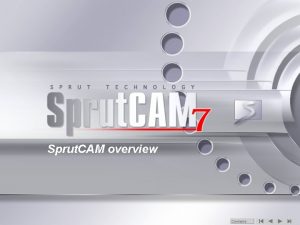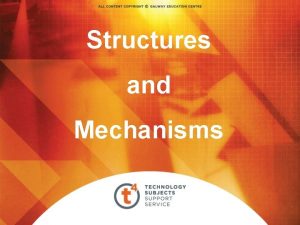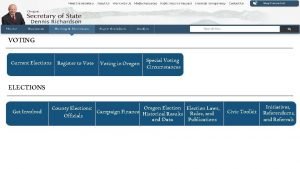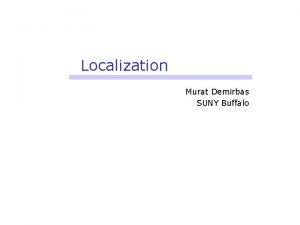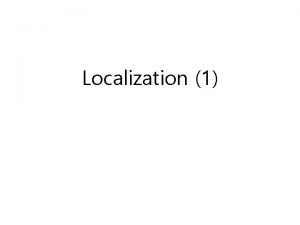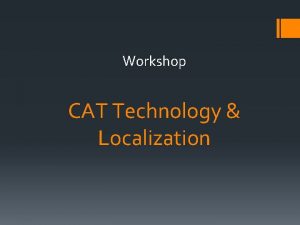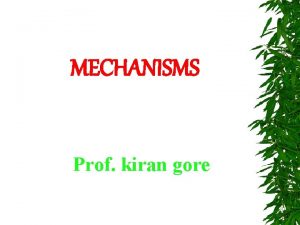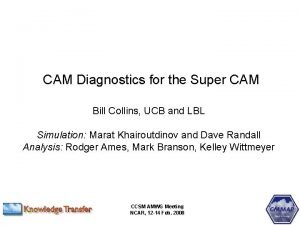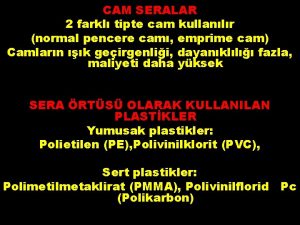Open Standard Voting Localization with CAM Localization Mechanisms





























































- Slides: 61

Open Standard Voting Localization with CAM - Localization Mechanisms - Publishing Localizations - Leveraging Open Standards - XSD ingesting David RR Webber Chair OASIS CAM TC (Content Assembly Mechanism) E-mail: drrwebber@acm. org http: //wiki. oasis-open. org/cam

Overview n n n Goal is to promote the use of open public standards for voting systems Develop in-country localizations from standard international base set Provide common open public lexicon for elections management and verification Leverage XML and open standards approach Provide developers with tools to aid delivery, documenting and testing of solutions 2

Approach Voting Localizations built with XSLT scripts n Open Public Standards n § W 3 C XML/XSD and § OASIS Content Assembly Mechanism (CAM) XML instance handling rules technology n CAM Designed for Interoperable Exchanges § Augments W 3 C XSD – fills in the gaps § Easier WYSIWYG format than XSD syntax § Supports use of XSLT for tool development j. CAM Eclipse editor environment provides convenient open desktop toolset n Available as Open Source on Source. Forge n 3

Localization Mechanisms Creating a Country Voting Localization Package

Creating a Package for Localization Step 1 - Ingest XSD – extract rules, structure, annotations n Step 2 - Select & mark out your use model in visual editor n Generate and save your “want list” selections n Step 3 - Generate your localized XSD schema subset n Step 4 - Generate rich live test data examples n § (complete with content hints / pass / fail / random options) n Run rules engine - verify operation and outcomes Step 5 - Build localization documentation of structure elements, usage and rules n Package and Share with solution partners and public n 5

Challenge: XSD is non-deterministic! n The schema contains the superset of every exchange component variation n XSD does not have direct context mechanisms n Hence people make everything in schema optional n Dependencies are not clear n It is difficult to understand the constructs and to document the rules clearly for business users to verify n It is hard to create test cases and instances (the “want list” tough to visualize) n Disconnect between XML data types and legacy data – e. g. dates, telephone formats, post codes 6

Localization check-list: § XSD schema structure model § CAM template + rules (deterministic) § Documentation of use patterns (aka “want list” + subset XSD) § Test cases and examples (pass/fail) § Content hinting (localization) § Validation engine for unit and regression testing § Open standard, open platform and open source allows consistent agreements between participants 7

Solution Conformance Testing Publish Structure Rules Context Examples Documentation XML Templates Package Test Cases 2 3 1 Validate Report html 4 XML Test Localization Content Hints Testing, Agreement / Alignment. Results Verify Result Outcomes Partner Uses & Creates XML Pass / Fail 8

Tutorial n Ingesting XSD schema § step by step example n Documenting the Localization Patterns § Creating “want list” selections § Subset XSD generation (for WSDL) § Documentation reporting options n Testing and Conformance § Creating Test Case examples § Content Hinting § Running Test Cases n Advanced Techniques 9

Ingesting XSD Schema Using j. CAM editor Wizard (http: //www. jcam. org. uk)

Ingesting XSD to CAM template format Structure OASIS EML XSD Collection XML Schema Common xsd Components XSLT tools process entire XSD collection Rules CIQ xsd INGEST Namespace Localization EML xsd Documentation EML xml CAM = Content Assembly Mechanism 11

Step 1 & 2 – Pick the XSD schema to ingest Specify XSD Locations 1 2 Choose File / New Option First location is the root folder for the XSD collection. Pick XSD Typically this is the same as the location for the XSD schema you want to ingest. (Complex XSD can have this in separate folder; hence need for option) 12

Step 3 – Choose the XSD parent element From the dropdown list pick the correct root element you wish to use. 3 XSD’s may have more than one collection in them (as shown here) or may not have the parent node element cleanly defined. The Wizard shows you the list of all possible ones it finds – so you can Choose XSD parent element select and confirm the right one. Confirm and start the XSD ingesting 13

Step 4 – Ingesting complete – Save Results Completed template is loaded and save dialogue appears 4 Processing usually takes a few seconds. Complex EML XSD can take over an hour to process however. Tip: j. CAM runs the ingesting as a background task – so you can continue to use the computer while such long ingesting is proceeding. 14

Step 5 – Review ingested structure Completed template is shown in the structure navigator panel for review and editing 5 Template contains all the default content model and structure rules ingested from the XSD. All annotations and documentation from XSD also ingested (show as “paperclip” symbol). Code lists and typical content values inserted for easy visual reference. 15

Console Log view displays messages Examining details of log messages to determine if any resolution is needed 16

Optional Advanced Selections Internal log message level – 1 is critical messages only, thru 4 which is “all”. Use this for debugging. Generation Mode – “Rules” is the normal mode; check “Annotations” to ingest notes and comment text as well. Diagnostics is for advanced debugging only. “inline” is normal mode; use “file” if your annotation results are too big for available memory Annotation Exclude – this allows selection of only main annotations – not those from imports. Items from matching namespaces are ignored. “text” is normal mode; use “all” if your annotations have embedded XML tags “want list” optimization; will exclude items marked to be ignored 17

Documenting the Localization Patterns “Want lists”, documentation and XSD subset generation

Building a Want List Make Want List Structure EML structure is all inclusive!!! Rules MARK WHAT IS NOT NEEDED Documentation excluded items DESIRED RESULTS 19

Marking Items for exclude - want list n Can exclude at all levels within the structure § exclude. Tree() § exclude. Element() § exclude. Attribute() n Use XPath operators to control scope: § § n Specific node Group of nodes Anywhere occurs in structure Contextually based on condition Can add new domain elements with own namespace and subset schema 20

Using Editor to mark exclude items Structure Editor Tools Select focus on item Invoke action menu (right mouse click) Pick action Tip: exclude rule display is context sensitive and only available on optional items Tip: use “Add New Rule” mode to specify different XPath for exclude (quick mode assumes “current path”) 21

Export and Save completed Want List File Menu Option Select Export and specify filename of destination. Excluded items are designated with red “dot” in structure editor and italics font with no bold highlight 22

Want List Details (Exported Example) EXCLUDE FLAG VALUE Want Lists provide a handy way to catalogue the localization model and can be re-used later by importing into other templates 23

Importing Want list operation File Menu Option Select Import and specify filename of your existing wantlist xml. Import process matches the path expressions in your want list to the XPath expressions in the template. Exclude statements generated for matching items. Makes it easy to re-apply a want list on new versions of schemas, or on similar schemas with same blocks of content – address, company, person, etc. 24

Adding New Domain Elements 1 2 Select root element node in structure; right mouse click for context menu; select “Add Namespace”; then enter prefix and URI Select element node in structure; right mouse click for context menu; select “Add Child Attribute / Element”; then enter prefix and name 25

Rule Validation + Interoperability Checks • • This option runs an analysis of your template and reports potential problems that it finds Also shows useful statistics about your template Tools Menu Option 26

Compress Operation File Menu Option Select option and specify filename for new copy of your template. Compress process removes all rules and structure items marked with an exclude statement. Note: ignores excludes that have a conditional context expression. Compress is OPTIONAL. You only need to do it for two reasons: a) to generate documentation of only your structure items b) to generate a new subset XSD schema 27

Generating sub-set schema File Menu Option Select Export CAM as XSD menu option Confirm the location and filename, and namespace mode. 1 2 Select ‘false’ for namespace use will minimize the use and requirement for namespaces in the subset schema and corresponding XML instance documents. 28

Schema sub-set generated Set of XSD files with filename and namespace suffix Each namespace file is import for those specific type definitions Reviewing XSD results in a schema editor tool 29

Constraint Schema Considerations n The CAM template allows full use of XPath conditional expressions and a rich set of over 30 functions including: § set. Number. Range(), set. Length(), set. Value(), set. Limit(), set. Date. Mask(), make. Repeatable(), restrict. Values(), exclude. Tree() Those that are compatible with XSD constraints will cause constraint schema assertions to be written out when exporting to schema n In the advanced topics section we will look at cross field validations using XPath conditional rules n 30

Generating Testing and Conformance Examples Selecting valid and invalid modes Run rules validation check Customizing content with Hints

Test Case Generation Quick Start File Menu Option Default directory to write examples into Name to be used for the examples How many examples to create Repeating elements count for Quick Test – just click “OK” to use default settings 32

Test Case Results Active links to view the generated examples 33

Advanced Generation Options Optional schema file validation link; use this to have example validate with schema or sub-set schema Use content type or item name (name is useful for checking backend transform processing) Use namespaces or not; if ‘false’ is selected – then XML instances are created with minimized namespace usage. How to handle optional items: all | random | none If you want deliberate errors for fail testing; (will give variety of data and structure errors) Optional content hints (explained next ) Use slider to pick a specific seed value – or leave blank for random seed 34

Test Case Generator Feature Summary n Make both Pass / Fail testing examples n Content hinting so examples use real not fake data n Test optional item logic with: all / random / none n Uses exclude() assertions so does not include those items – makes realistic examples of your use pattern n Can pass in seed value – use when adding and testing hints (each test case is labelled with its seed value) n Make hundreds of test cases without manual editing n Can link test case to XSD schema for structure tests n You can modify XSLT to meet own testing needs 35

Run CAM Rules Check on Examples Run Menu Option 1 Pick Test Case Example to VALIDATE; click Finish to run validation rules 2 Review validation results 3 36

Content Hinting Mechanisms n n n Designed to create realistic data examples Hints can be provided in two ways Firstly - using ‘Value’ notes in annotations on specific items in the structure editor Second – create your own Hints XML file and add matching rules to globally apply across your template(s) – e. g. First. Name, Last. Name, Address, Birth. Date, etc. Can export from one template, import into another 37

First Approach: annotation Value Hints Select focus on structure item Invoke action menu (right mouse click) Choose “Edit Annotations” 38

Then add Value annotation item 3 Select “Value” tab 2 4 Enter values terminated with “|” character 1 Click on “Add New”, then enter “Value” as Type and confirm “OK” 5 Re-run Example export to see results 39

Second: Hints File Mechanism (XML file) 1 like / with partial name matching use for component match on items – e. g. first with name matches <nxnl: first_name> 2 key matching on tag name use for exact match of items 3 key / parent path matching use when same name occurs within different parents – e. g. Country and Person / Name. Element with different content and context Note: matching is case sensitive but ignores namespaces TIP: can use Export Hints to create initial XML file for editing 40

A- Using Examples Generator with Hints Select XML hints file to be used here 41

B- Import Hints into Annotations (merge) set and select as needed Option to autoreload new anno file into current template 42

Documentation Default reporting options

Documentation Layouts n Five options § § § Source XML Component details (XML) Tabular format (HTML) Interactive web page (wiki) Code list Tabular format page layout for data analyst use and designed to make rules and use patterns clear n Each documentation layout XSLT script can be customized as desired n 44

Open Documentation Mechanism Structure Editor runs XSLT on CAM CXF to output results as HTML document n External CSS style sheet controls HTML content formatting, colors, fonts. n Editor Preferences menu allows overriding of default documentation style sheets n CAM Template XML (CXF) XSLT script Documentation Generator customizable HTML Report Pages CSS style sheet 45

Tabular Documentation Menu Option Select Format, resulting HTML opens in browser viewer 46

Tabular HTML Content Details Clear use pattern Extended Code list handling Annotations XPath references and functions Enhanced Data type Logic 47

Summary Ingesting XSD n Creating use pattern (aka want list) n Generating test examples n Hints system n Generate XSD schema subset n Running tests n

Localization Checklist Review 1 5 XML Schema 2 Documentation 3 Want List in XML XSD subset 4 Examples & Test Cases (Word / PDF / Open. Doc Excel / HTML) CAM Template Structure Rules Context Vocabulary Templates 49

Summary n Capabilities covered § § § Ingesting XSD Creating use pattern (aka want list) Generating test examples Hints system Generate XSD schema subset Running tests Applicable to board range of domains and schemas n Enhanced interoperability through consistent method, testing and shared clear exchange package definitions n Enables consistent implementations n 50

Advanced Techniques Extending rules for actual use cases n Using XPath selector wizard n Handling ingestion recursion issues n Source. Forge XSLT repository n

Extending Rules for actual use cases n Emergency Response Services Workflow using OASIS EDXL exchanges 52

Illustrative EDXL requirements n n n When Adult. ICU Bed type > 0 - AND Triage Quantity > 5 Facility Matching Require Facility State = CA, NV, NM When Admissions Total > 50 - AND Deaths > 0 Region Restriction Outbreak alerting 53

Template rules syntax <as: Business. Use. Context> <as: Rules> <as: default> <as: context> <as: constraint condition="//Activity 24 Hr /Admissions > ‘ 50’ and( // Activity 24 Hr /Deaths > ‘ 0’)" action="restrict. Values(// Activity 24 Hr /Admissions, ‘Alert – possible outbreak’) "/> <as: constraint action="restrict. Values(//ns 5: Administrative. Area /ns 5: Name. Element , 'CA|NV|NM')"/> </as: context> </as: default> </as: Rules> </as: Business. Use. Context> 54

XPath selector wizard XPath syntax is automatically generated for you Check boxes allow user to select scope of rule action Conditional context rules can be optionally used Documentation notes can be added here 55

Ingestion Recursion Handling In XSD schema syntax – recursive links and type references are not marked as such n Ingestion process has no way of knowing when recursion is about to occur n Solution – add annotation to XSD schema element definition: n § <xsd: annotation> <xsd: documentation> <recursive/> </xsd: documentation> </xsd: annotation> 56

Source. Forge XSLT svn repository n Using any svn client the XSLT scripts can be retrieved from: § https: //camprocessor. svn. sourceforge. net/svnroot/camprocessor/c amed/uk. org. jcam. camed/trunk/xsl/ 57

“CAM Kit” of XSLT tools used n XSD 2 Schema § expands original target schema resolving imports and includes n XSD 2 CAM § extracts structure and rules and builds template from schema n XML 2 Wantlist § builds want list from any XML instance (uses Level Depth setting) n CAM 2 Examples § Generates a collection of XML instance test cases n Import/Export Hints § Manage and apply content hinting across CAM templates n CAM 2 XSD export § Creates a subset XSD from CAM template (applies want list) 58

Resources / Installation Selection of useful links and additional technical details

Quick Install for Eclipse j. CAM Editor n Download the latest editor ZIP file from the download site on Source. Forge: § http: //downloads. sourceforge. net/sourceforge/camprocessor n n n Create folder c: j. CAM Open up the ZIP file and extract the CAMed folder into c: j. CAMCAMed From the c: j. CAMCAMed directory click on the CAMed. exe icon to run the program Create shortcut to the CAMed. exe by right click on icon and select create shortcut Drag and drop shortcut to desktop 60

Resources: www. oasis-open. org/committees/election docs. oasis-open. org/election www. oasis-open. org/committees/cam wiki. oasis-open. org/cam docs. oasis-open. org/cam www. jcam. org. uk 61
 Ntsu eeclass
Ntsu eeclass Cam error
Cam error Wedge and flat cam
Wedge and flat cam Cam 2cam chat
Cam 2cam chat Open innovation open science open to the world
Open innovation open science open to the world Imf functions
Imf functions Higher modern studies voting behaviour essay
Higher modern studies voting behaviour essay Voting rights
Voting rights Voting by feet tiebout
Voting by feet tiebout Hough voting
Hough voting Voting districts definition ap human geography
Voting districts definition ap human geography Sociological factors that affect voting behavior
Sociological factors that affect voting behavior Deployment diagram notations
Deployment diagram notations Deployment diagram for online voting system
Deployment diagram for online voting system Brainpop political parties
Brainpop political parties Sms poll voting
Sms poll voting Online voting system project proposal
Online voting system project proposal Hough voting
Hough voting Activity diagram for online voting system
Activity diagram for online voting system Which statement best summarizes the water cycle?
Which statement best summarizes the water cycle? Red line voting
Red line voting Meetoo voting
Meetoo voting Vevox voting
Vevox voting Vtools enotice
Vtools enotice Pros and cons of fptp
Pros and cons of fptp Instant runoff voting excel template
Instant runoff voting excel template What are the four common methods of voting in ffa
What are the four common methods of voting in ffa Example of contextualization and localization
Example of contextualization and localization Voice localization using nearby wall reflections
Voice localization using nearby wall reflections Neural network ib psychology
Neural network ib psychology Localisation of distributed data
Localisation of distributed data Query decomposition in distributed database
Query decomposition in distributed database Discrete bayes filter
Discrete bayes filter Localization of behavior
Localization of behavior Buccal object rule
Buccal object rule Monte carlo localization for mobile robots
Monte carlo localization for mobile robots Icu localization
Icu localization Basic concepts of probability
Basic concepts of probability Tracking cmsc
Tracking cmsc Markov localization
Markov localization Localization in mobile computing
Localization in mobile computing Inclusive localization
Inclusive localization Markov localization
Markov localization Monte carlo localization python
Monte carlo localization python Deped mission and vision
Deped mission and vision Felix sasaki
Felix sasaki Localization and contextualization
Localization and contextualization Localisation industry standards association
Localisation industry standards association Anderson localization lecture notes
Anderson localization lecture notes Dnn roadmap
Dnn roadmap Dynamics nav localization
Dynamics nav localization Mobile robot localization
Mobile robot localization Erp localization
Erp localization Method of localization of radiopharmaceuticals
Method of localization of radiopharmaceuticals Nociceptive sensation
Nociceptive sensation Www.youtube.com
Www.youtube.com Action localization
Action localization Website localization statistics
Website localization statistics Localization courses
Localization courses Lqa language quality assurance
Lqa language quality assurance Globalization testing example
Globalization testing example The standard error of the mean
The standard error of the mean
